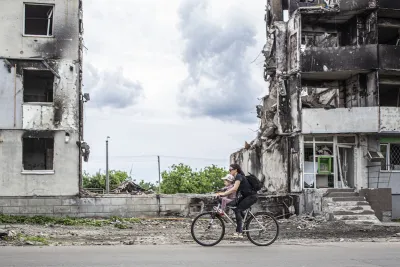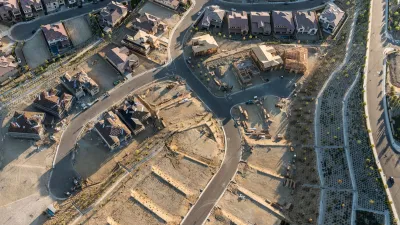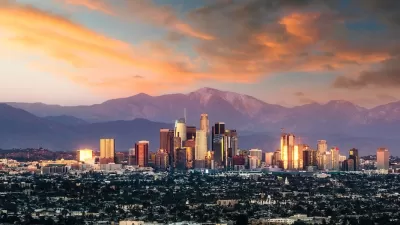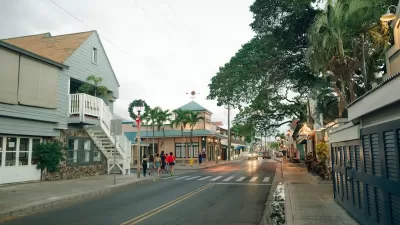Rebuilding in ways that are more environmentally, socially, and economically sustainable in the face of ongoing conflict.

This is the second in a series of posts reflecting on urbanism and rebuilding efforts in Ukraine following the Russian invasion in 2022. Read the first post here.
I often find myself talking about energy when trying to describe what it’s like to live and work in Ukraine during the ongoing invasion. Since I first arrived in the country in June 2022, I became acutely aware of some hidden, powerful current flowing through Ukraine’s streets — a kind of organic, sustainable energy generated by the resilience of its people. It is a power source to be reckoned with, fueling a collective spirit to rebuild war-torn neighborhoods and inspiring fresh visions of better urban lives.
A similar energy is present in any war zone or area struck by disaster or crisis. You saw it during the Los Angeles fires: everyone interviewed by journalists spoke with a certain intensity as they described what was happening.
“Crises create not only severe devastation, but a unique opportunity for systemic change and fundamental re-invention,” write the authors of Effective Crisis Communication: Moving from Crisis to Opportunity. “In normal times, such fundamental change would require long-term strategic efforts as well as major investments of time and resources without guaranteed success. Crises, however, disrupt the status quo in basic ways allowing for new assumptions, methods and organizational values to emerge.”
As an urbanist volunteering in Ukraine for two and half years, I tap into this renewable resource, helping to design spaces that capture the raw potential of a society galvanized by hardship. This energy is not just a metaphor; it’s a palpable force forged on the anvil of conflict and disaster—a force that underpins every idea for urban improvement and the insistence of imagining a better, more sustainable future.
I had no plans to volunteer as an urbanist in a war zone back in 2022 when Russian troops were on the outskirts of Kyiv. It required a call to action, which came at 11:06 on 25 April, 2022 when I received an email from Vadym and Orest, two urban planners in Ukraine. It was a clear appeal for help: they needed used bikes from Denmark.
The City of Lviv in western Ukraine had been inundated with 200,000 Internally Displaced People (IDPs), a massive influx for a city of 700,000. Bikes could alleviate transport chaos and give the IDPs freedom of mobility after having left everything behind in Ukraine’s East.
I remember it so clearly: standing in my apartment in Copenhagen, feeling so helpless since the invasion started on Europe’s doorstep. What a feeling to read that appeal for help from colleagues and for something that was firmly in my wheelhouse. My call to action was loud and clear and I responded.
Bikes as humanitarian aid
I started a non-profit called Bikes4Ukraine.org and tried to figure out how to get used bikes from Copenhagen to Lviv. I have designed bicycle infrastructure in cities around the world and had written a book about it, but I needed to learn fast about logistics.
The first shipment arrived in July 2022, and we distributed them to IDPs in camps outside the city center. It was a powerful experience to see humble bicycles create joy and gratitude among adults and children alike.
I continued shipping bikes, but soon realized that there was another need. Social workers and volunteers needed bikes to deliver food, water, medicine and humanitarian aid to vulnerable citizens in the most devastated areas of Ukraine. Bikes arriving as humanitarian aid end up delivering humanitarian aid — that poetry never gets old. All of our bikes fulfill this purpose.
In one year, just one unwanted bike from Europe will take 3600 trips, travel 10,800 km, carry 18,000 kg of essential goods (which also frees up space in vans and trucks for other goods) and will help 7000 people. We have delivered 1250 bikes so far, from my network in Denmark, Germany, Belgium, France and Hungary.
I visited Ukraine several times with Bikes4Ukraine, but I was soon drawn in deeper. In late 2022, The Mayor of Mykolaiv, Oleksandr Senkevich, said something catalytic to me as we sat and talked in a cafe, with Russian forces hammering the city from the front line 10 km away.
Half my population has left. This is my time to create a better city for them when they return. This war is an opportunity for positive urban change.
That sums up how Ukrainians roll — and I got onboard. It’s been a wild ride. I can do things here as an urbanist that I can’t do anywhere else in the world and certainly not as quickly and effectively. At the Mayor’s behest, my team designed the Cycling Strategy for Mykolaiv with a comprehensive plan for creating a bicycle-friendly city.
Public space as healing
In 2024, I worked with 1000 volunteers to build the first Nordic Therapy Garden to heal mental trauma and PTSD, in a forested area next to the country’s largest psychiatric hospital. This spring, we’ll open the first Community Garden in Kyiv. The garden will rescue an abandoned plot of land from developers, while giving locals a green oasis in which they can strengthen their food security, interpersonal relationships and mental and physical well-being.
And our new NGO, DIY Ukraine, is designing and planning nothing less than the world’s largest pop-up urban space, utilizing tactical urbanism. For 1500 years, the area around Kontraktova Square has been the veritable beating heart of Kyiv; it is the crossroads of the entire region with a thriving market. For the past ten years, however, the 11,000 m2 has been neglected, and it’s now a vast asphalt wasteland with people hurrying through. A square as iconic as Kontraktova can be made better. The people of the Podil neighborhood in particular and of Kyiv in general deserve a better public space after three years of war.
We hope to activate this space with trauma-sensitive accessible seating, greenery and shade that will also tackle the heat island effect. With key support from the Danish pharmaceutical company Novo Nordisk, our facilities for sport and recreation will help Kyivians strengthen their bodies and minds. Urbanism is a tool and also a medicine.
I didn’t see any of this coming back in April 2022, but now it is my daily life. It is an odd existence. My carefully managed and cherished Danish work-life balance is absent. Every day is a work day. My anxiety disorder ebbs and flows 24/7 with constant air raids and attacks, and with the insecurity of fundraising. Do I stop? Not an option. I’m plugged firmly into this invisible power source. It feeds me.
We’ve all heard the word resilience used frequently to describe the Ukrainian people since 2022. Let me be brutally honest. It’s different now. The Ukrainian people are tired. They are standing firm in the defense of their nation. In 2022, you could leave a bar with a loud Slava Ukraini! (Glory to Ukraine) and strangers would respond with a resounding “Heroyam Slava!” (Glory to the heroes). Sitting here today, I can’t remember the last time I heard “Slava Ukraini,” except from politicians.
Resilience has morphed into the Finnish concept of sisu. Where resilience describes the ability to bounce back from setbacks and adapt to challenges, sisu is extraordinary determination, inner strength and a stubborn resolve to push beyond limits. Sisu is the part of us that comes alive when we feel as if we have nothing left, when we think we cannot go on, but we do because we must. We can fix that public space. We can plant those trees. We can improve sidewalks for veterans with new prosthetics or wheelchairs. We can do it together.
There is a new, refreshed sense of togetherness. Since the US election and especially since the inauguration, there has been a noticeable increase in the number of foreigners contacting us about coming to Ukraine to volunteer. Last week DIY Ukraine hosted an American couple who came to help. They fixed bikes and knitted camouflage nets for the front lines. They were 72 and 79 years old and worked so hard.
There has been a kind of Spanish Civil War vibe in Ukraine since the beginning of the invasion, with volunteers coming from around the world to help. We are see a renewal of that spirit as people try to counterbalance the bizarre geo-political climate with their desire to do something—anything.
Not every urbanist or architect reading this can show up on the Ukrainian border and not everyone would want to. Fair enough. Perhaps you can support our work through crowdfunding. But for those who make the trip, I can guarantee that you’ll feel that invisible current running through your body and soul. We have a power drill ready for you and rewarding tactical urbanism projects with Ukrainians that will leave their mark on you. There is only one leader of the free world right now: Ukraine.
Mikael Colville-Andersen is an urban designer, author and a leading global voice in urbanism. He is known for his pioneering philosophies about simplifying urban planning and how cities and towns should be designed instead of engineered. He currently works in Ukraine, redesigning bombed cities and sending used bikes to the country with his NGOs Bikes4Ukraine.org and DIY-Ukraine.com.

Study: Maui’s Plan to Convert Vacation Rentals to Long-Term Housing Could Cause Nearly $1 Billion Economic Loss
The plan would reduce visitor accommodation by 25,% resulting in 1,900 jobs lost.

Alabama: Trump Terminates Settlements for Black Communities Harmed By Raw Sewage
Trump deemed the landmark civil rights agreement “illegal DEI and environmental justice policy.”

Why Should We Subsidize Public Transportation?
Many public transit agencies face financial stress due to rising costs, declining fare revenue, and declining subsidies. Transit advocates must provide a strong business case for increasing public transit funding.

Paris Bike Boom Leads to Steep Drop in Air Pollution
The French city’s air quality has improved dramatically in the past 20 years, coinciding with a growth in cycling.

Why Housing Costs More to Build in California Than in Texas
Hard costs like labor and materials combined with ‘soft’ costs such as permitting make building in the San Francisco Bay Area almost three times as costly as in Texas cities.

San Diego County Sees a Rise in Urban Coyotes
San Diego County experiences a rise in urban coyotes, as sightings become prevalent throughout its urban neighbourhoods and surrounding areas.
Urban Design for Planners 1: Software Tools
This six-course series explores essential urban design concepts using open source software and equips planners with the tools they need to participate fully in the urban design process.
Planning for Universal Design
Learn the tools for implementing Universal Design in planning regulations.
Smith Gee Studio
Alamo Area Metropolitan Planning Organization
City of Santa Clarita
Institute for Housing and Urban Development Studies (IHS)
City of Grandview
Harvard GSD Executive Education
Toledo-Lucas County Plan Commissions
Salt Lake City
NYU Wagner Graduate School of Public Service





























